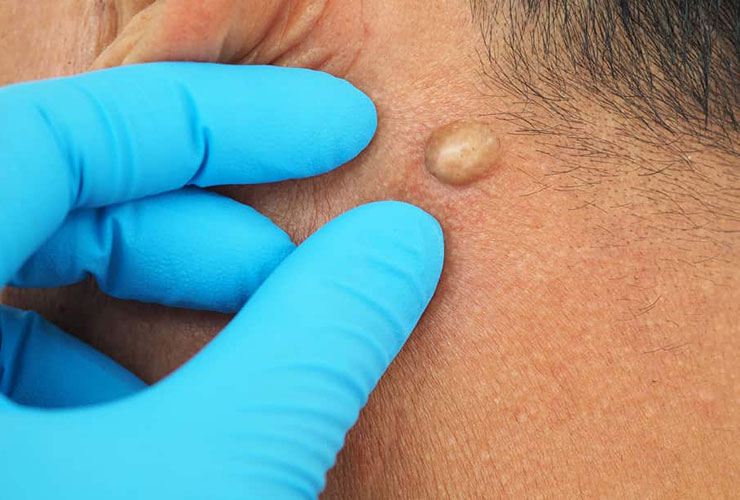A sebaceous cyst, also known as an epidermoid cyst, is a non-cancerous, closed sac or lump located just beneath the skin. These cysts typically form when a hair follicle or oil gland becomes blocked, leading to the accumulation of a substance called sebum, which is an oily, waxy material produced by the skin’s sebaceous glands. Sebaceous cysts are common and can occur anywhere on the body, but they are most frequently found on the face, neck, back, or genital area.
Here are some key points about sebaceous cysts:
- Appearance: Sebaceous cysts are usually round or oval in shape and may range in size from a small pea to a few centimeters in diameter. They are typically firm, mobile, and smooth to the touch. The cyst may be flesh-colored or have a slight bluish tint, and it can sometimes be seen through the skin.
- Symptoms: Sebaceous cysts are generally painless unless they become infected or inflamed. Infection can cause redness, tenderness, warmth, and the cyst may discharge a foul-smelling, thick, yellowish substance. If you experience these symptoms, seek medical attention.
- Diagnosis: A healthcare provider can usually diagnose a sebaceous cyst through a physical examination. In some cases, they may order imaging tests like ultrasound or a CT scan to confirm the diagnosis or evaluate the size and location of the cyst.
- Treatment: Treatment for a sebaceous cyst may not always be necessary, especially if it’s small, painless, and not causing any cosmetic concerns or discomfort. However, if treatment is desired or the cyst becomes infected or bothersome, here are the main options:
Incision and Drainage: A healthcare provider can make a small incision in the cyst and drain the contents. This is a temporary solution and may not prevent the cyst from returning.
Surgical Excision: This is the most common method of treatment. A surgeon makes an incision in the skin, removes the entire cyst, and stitches the wound. This approach is more likely to prevent recurrence.
Laser Removal: Some cysts can be removed using laser technology, which involves cutting and sealing the cyst’s contents and removing the sac.
Steroid Injections: In certain cases, steroid injections may be used to reduce inflammation in and around the cyst. - Complications: If a sebaceous cyst becomes infected, it can lead to an abscess, which is a more severe infection that may require drainage and antibiotics. Additionally, attempting to squeeze or pop a sebaceous cyst at home can increase the risk of infection and scarring and should be avoided.
- Recurrence: Sebaceous cysts can sometimes recur even after surgical removal. Proper surgical excision, which includes removing the cyst and its sac, reduces the likelihood of recurrence.
If you have a sebaceous cyst that is causing you discomfort or if you suspect it’s infected, it’s important to consult a healthcare provider. They can evaluate the cyst, recommend appropriate treatment options, and help prevent potential complications.

